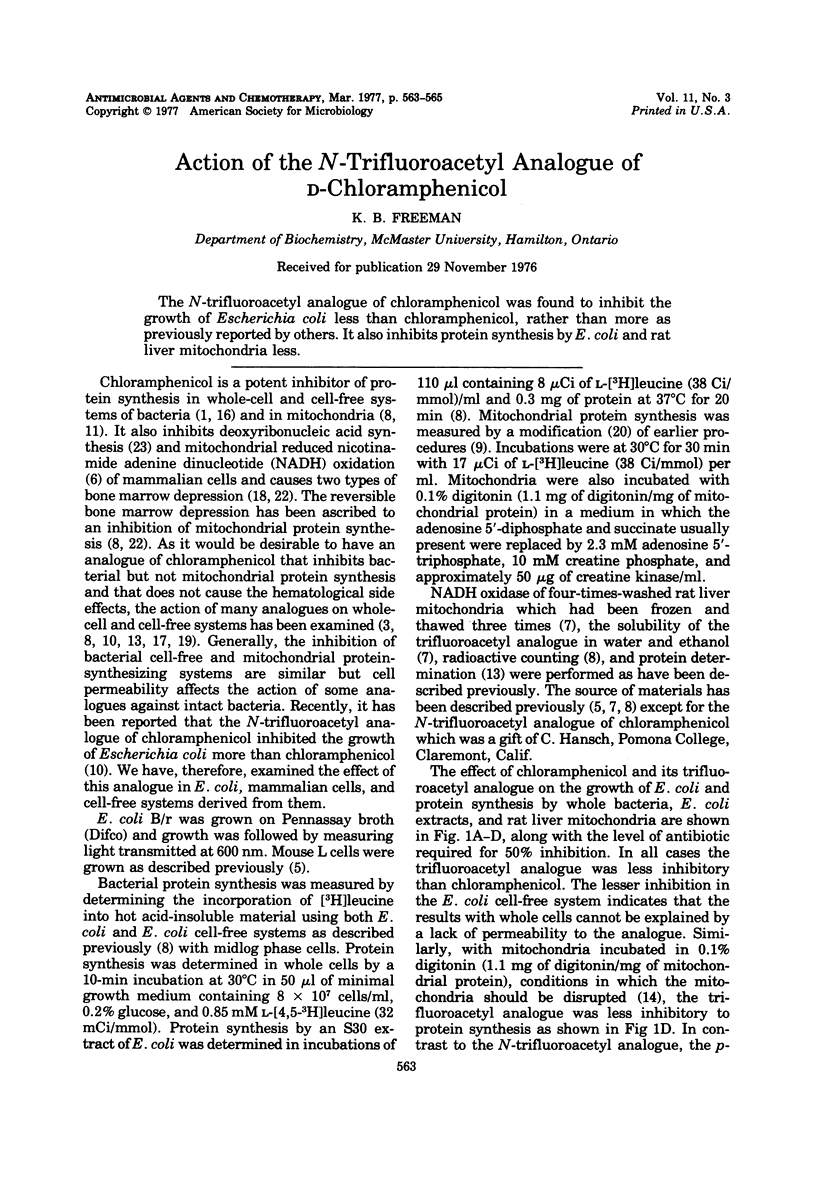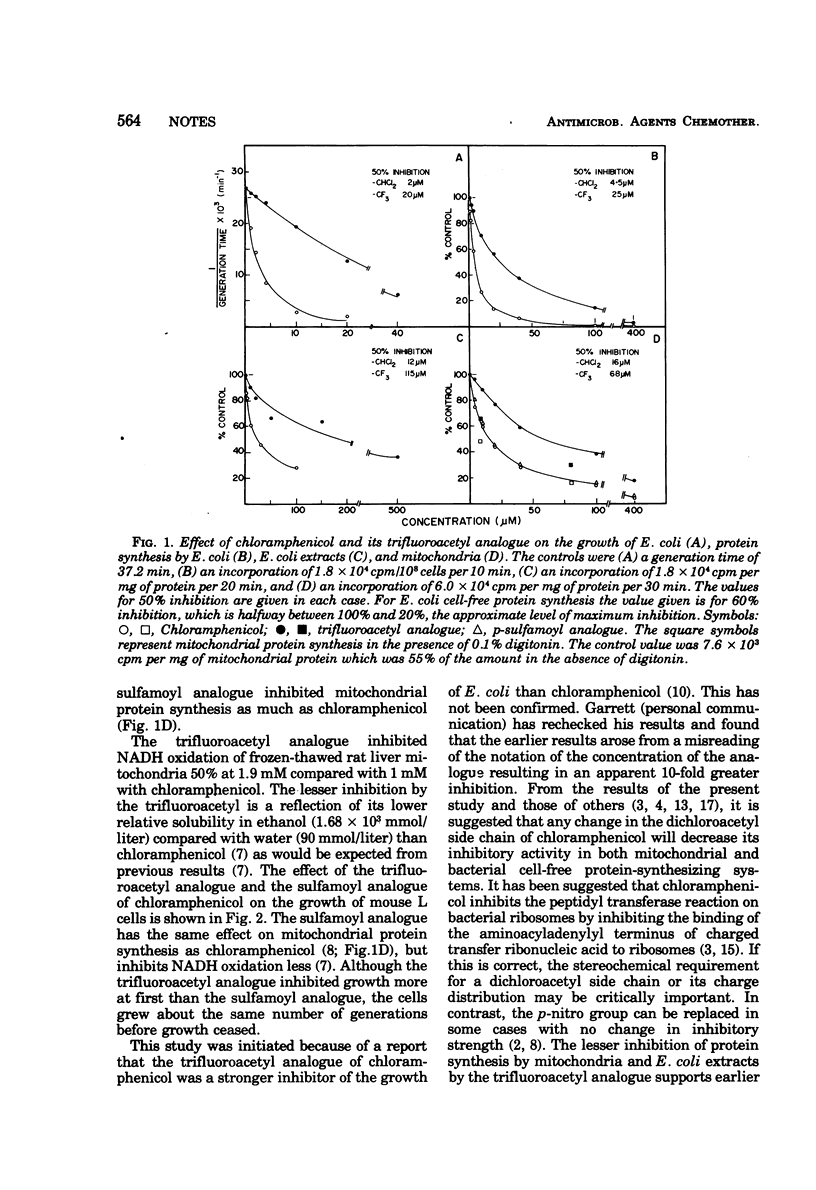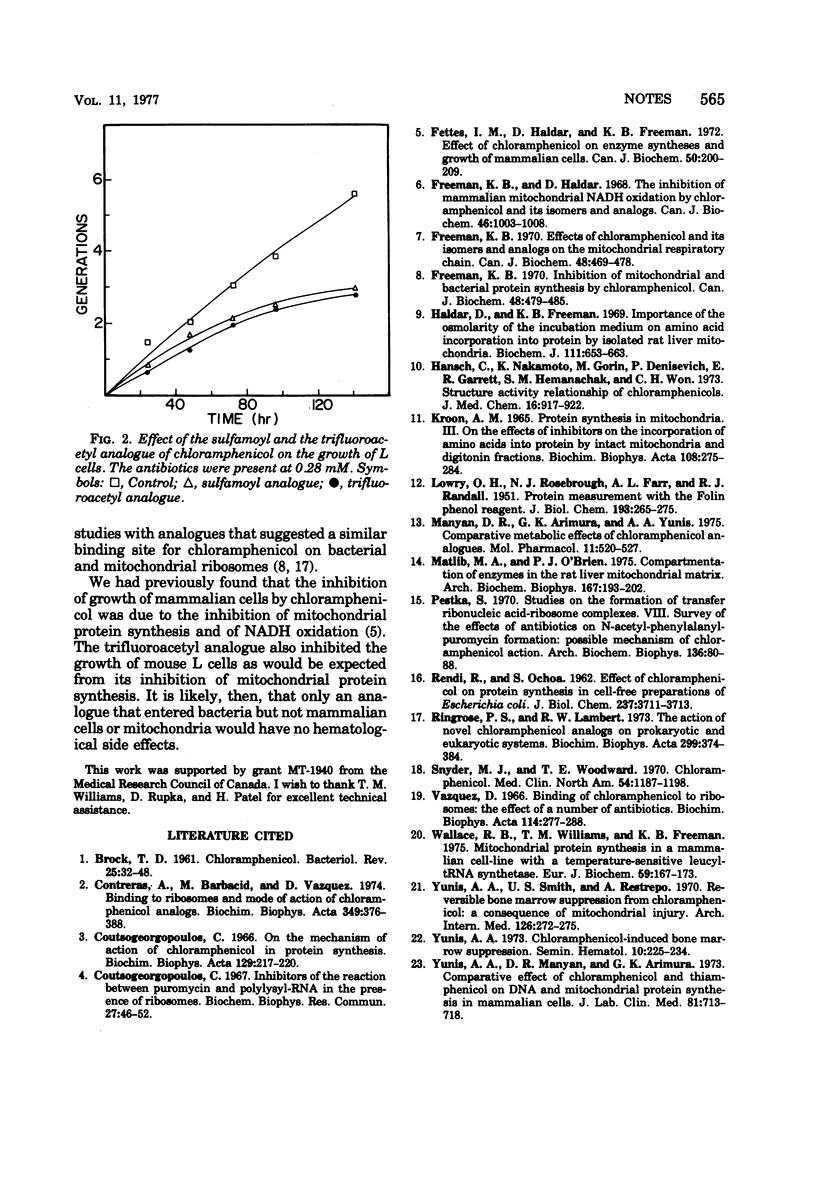Abstract
The N-trifluoroacetyl analogue of chloramphenicol was found to inhibit the growth of Escherichia coli less than chloramphenicol, rather than more as previously reported by others. It also inhibits protein synthesis by E. coli and rat liver mitochondria less.
Full text
PDF


Selected References
These references are in PubMed. This may not be the complete list of references from this article.
- Brock T. D. CHLORAMPHENICOL. Bacteriol Rev. 1961 Mar;25(1):32–48. doi: 10.1128/br.25.1.32-48.1961. [DOI] [PMC free article] [PubMed] [Google Scholar]
- Contreras A., Barbacid M., Vazquez D. Binding to ribosomes and mode of action of chloramphenicol analogues. Biochim Biophys Acta. 1974 May 31;349(3):376–388. doi: 10.1016/0005-2787(74)90124-5. [DOI] [PubMed] [Google Scholar]
- Coutsogeorgopoulos C. Inhibitors of the reaction between puromycin and polylysyl-RNA in the presence of ribosomes. Biochem Biophys Res Commun. 1967 Apr 7;27(1):46–52. doi: 10.1016/s0006-291x(67)80037-8. [DOI] [PubMed] [Google Scholar]
- Fettes I. M., Haldar D., Freeman K. B. Effect of chloramphenicol on enzyme synthesis and growth of mammalian cells. Can J Biochem. 1972 Feb;50(2):200–209. doi: 10.1139/o72-027. [DOI] [PubMed] [Google Scholar]
- Freeman K. B. Effects of chloramphenicol and its isomers and analogues on the mitochondrial respiratory chain. Can J Biochem. 1970 Apr;48(4):469–478. doi: 10.1139/o70-076. [DOI] [PubMed] [Google Scholar]
- Freeman K. B., Haldar D. The inhibition of mammalian mitochondrial NADH oxidation by chloramphenicol and its isomers and analogues. Can J Biochem. 1968 Sep;46(9):1003–1008. doi: 10.1139/o68-151. [DOI] [PubMed] [Google Scholar]
- Freeman K. B. Inhibition of mitochondrial and bacterial protein synthesis by chloramphenicol. Can J Biochem. 1970 Apr;48(4):479–485. doi: 10.1139/o70-077. [DOI] [PubMed] [Google Scholar]
- Haldar D., Freeman K. B. Importance of the osmolarity of the incubation medium on amino acid incorporation into protein by isolated rat liver mitochondria. Biochem J. 1969 Mar;111(5):653–661. doi: 10.1042/bj1110653. [DOI] [PMC free article] [PubMed] [Google Scholar]
- Hansch C., Nakamoto K., Gorin M., Denisevich P., Garret E. R., Heman-Ackah S. M., Won C. H. Structure-activity relationship of chloramphenicols. J Med Chem. 1973 Aug;16(8):917–922. doi: 10.1021/jm00266a011. [DOI] [PubMed] [Google Scholar]
- Kroon A. M. Protein synthesis in mitochondria. 3. On the effects of inhibitors on the incorporation of amino acids into protein by intact mitochondria and digitonin fractions. Biochim Biophys Acta. 1965 Oct 11;108(2):275–284. doi: 10.1016/0005-2787(65)90012-2. [DOI] [PubMed] [Google Scholar]
- LOWRY O. H., ROSEBROUGH N. J., FARR A. L., RANDALL R. J. Protein measurement with the Folin phenol reagent. J Biol Chem. 1951 Nov;193(1):265–275. [PubMed] [Google Scholar]
- Manyan D. R., Arimura G. K., Yunis A. A. Comparative metabolic effects of chloramphenicol analogues. Mol Pharmacol. 1975 Sep;11(5):520–527. [PubMed] [Google Scholar]
- Matlib M. A., O'Brien P. J. Compartmentation of enzymes in the rat liver mitochondrial matrix. Arch Biochem Biophys. 1975 Mar;167(1):193–202. doi: 10.1016/0003-9861(75)90456-7. [DOI] [PubMed] [Google Scholar]
- Pestka S. Studies on the formation of transfer ribonucleic acid-ribosome complexes. 8. Survey of the effect of antibiotics of N-acetyl-phenylalanyl-puromycin formation: possible mechanism of chloramphenicol action. Arch Biochem Biophys. 1970 Jan;136(1):80–88. doi: 10.1016/0003-9861(70)90329-2. [DOI] [PubMed] [Google Scholar]
- RENDI R., OCHOA S. Effect of chloramphenicol on protein synthesis in cell-free preparations of Escherichia coli. J Biol Chem. 1962 Dec;237:3711–3713. [PubMed] [Google Scholar]
- Snyder M. J., Woodward T. E. The clinical use of chloramphenicol. Med Clin North Am. 1970 Sep;54(5):1187–1197. [PubMed] [Google Scholar]
- Vazquez D. Binding of chloramphenicol to ribosomes. The effect of a number of antibiotics. Biochim Biophys Acta. 1966 Feb 21;114(2):277–288. doi: 10.1016/0005-2787(66)90309-1. [DOI] [PubMed] [Google Scholar]
- Wallace R. B., Williams T. M., Freeman K. B. Mitochondrial protein synthesis in a mammalian cell-line with a temperature-sensitive leucyl-tRNA synthetase. Eur J Biochem. 1975 Nov 1;59(1):167–173. doi: 10.1111/j.1432-1033.1975.tb02438.x. [DOI] [PubMed] [Google Scholar]
- Yunis A. A. Chloramphenicol-induced bone marrow suppression. Semin Hematol. 1973 Jul;10(3):225–234. [PubMed] [Google Scholar]
- Yunis A. A., Manyan D. R., Arimura G. K. Comparative effect of chloramphenicol and thiamphenicol on DNA and mitochondrial protein synthesis in mammalian cells. J Lab Clin Med. 1973 May;81(5):713–718. [PubMed] [Google Scholar]
- Yunis A. A., Smith U. S., Restrepo A. Reversible bone marrow suppression from chloramphenicol. A consequence of mitochondrial injury. Arch Intern Med. 1970 Aug;126(2):272–275. [PubMed] [Google Scholar]


